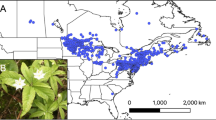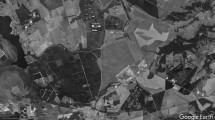Abstract
The threshold below which population declines impact the effectiveness of plant reproduction is essential for the identification of populations that can no longer spontaneously recover following habitat management or restoration, below the minimum viable population (MVP) size. We hypothesized that risk of reproductive limitation can be evaluated from combined analysis of pollen activity, ovule fertilization and germination in the context of population demographics and fragmentation. The marsh gentian (Gentiana pneumonanthe), a rare emblematic species of European heathland and fen, was investigated at the southern limit of its range in eighteen populations encompassing one to several hundred thousand individuals, spanning small fragments to extensive well-preserved areas. An index of habitat fragmentation was determined from GIS; field surveys determined the ratio of juvenile to reproductive age states; fluorescence microscopy of pistils determined, for each population, the proportion of flowers exhibiting active pollen tube growth. Analysis of seed lots determined the ovule fertilization rate and seed germination capacity. Some of the small populations occupying restricted habitat fragments showed high rates of pollination (100%) and ‘normal’ age state demographics. However, reproductive characters all exhibited exponential rise to maximum relationships with population size, indicating clear tipping points (for pollination, at a threshold of 7 reproductive adults, and for ovule fertilization rate and germination at 42 reproductive adults). Thus although small populations may set seed, exhibit a ‘normal’ age state structure, and may appear viable, reproductive effectiveness declines when population size falls below 42 generative individuals and < 7 is an indicator of strong limitation. Although many remnant populations of G. pneumonanthe are in the order of 50–150 individuals these should be not be considered as MVPs; they are on the brink of calamity.


Similar content being viewed by others
References
Aguilar R, Ashworth L, Galetto L, Aizen MA (2006) Plant reproductive susceptibility to habitat fragmentation: review and synthesis through a meta-analysis. Ecol Lett 9(8):968–980
Aizen MA, Harder LD (2007) Expanding the limits of the pollen-limitation concept: effects of pollen quantity and quality. Ecology 88(2):271–281
Allee WC (1931) Animal aggregations, a study in general sociology. University of Chicago Press, Chicago
Allee WC (1938) The social life of animals. Norton, New York
Bach A, Pawłowksa B (2003) Somatic embryogenesis in Gentiana pneumonanthe L. Acta Biol Crac Ser Bot 45(2):79–86
Brusa G (2008) Study of heath (Calluna vulgaris) vegetation formations of the Brughiera Briantea Park and the Province of Como (original title, Studio delle formazioni vegetali a brugo (Calluna vulgaris) del Parco Brughiera Briantea e della Provincia di Como). Consorzio del Parco Brughiera Briantea (in the Italian language)
Brys R, Jacquemyn H, Endels P, Hermy M, De Blust G (2003) The relationship between reproductive success and demographic structure in remnant populations of Primula veris. Acta Oecol 24:247–253
Cerabolini BEL, Brusa G, Ceriani RM, Armiraglio S, De Molli C, Pierce S (2017) Ecology and floristic composition of heathlands in the Po basin and the Southern Alps (NW Italy). Bot Lett. https://doi.org/10.1080/23818107.2017.1387077
Chebli Y, Geitmann A (2007) Mechanical principles governing pollen tube growth. Funct Plant Sci Biotechnol 1(2):232–245
den Nijs HCM, Oostermeijer JGB (1997) Reproductive biology and gene flow in a fragmented landscape. Bocconea 7:153–165
Derksen J, Rutten T, Van Amstel T, De Win A, Doris F, Steer M (1995) Regulation of pollen tube growth. Acta Botanica Neerl 44(2):93–119
Ellstrand NC (1992) Gene flow by pollen, implications for plant conservation genetics. Oikos 63:77–86
Endels P, Jacquemyn H, Rein B, Hermy M (2007) Reinstatement of traditional mowing regimes counteracts population senescence in the rare perennial Primula vulgaris. Appl Veg Sci 10:351–360
Engel EC, Irwin RE (2003) Linking pollinator visitation rate and pollen receipt. Am J Bot 90(11):1612–1618
Goverde M, Schweizer K, Baur B, Erhardt A (2002) Small-scale habitat fragmentation effects on pollinator behaviour, experimental evidence from the bumblebee Bombus veteranus on calcareous grasslands. Biol Conserv 104:293–299
Hegland SJ, van Leeuwen M, Oostermeijer JGB (2001) Population structure of Salvia pratensis in relation to vegetation and management of Dutch dry floodplain grasslands. J Appl Ecol 38:1277–1289
Holdaway-Clarke TL, Hepler PK (2003) Control of pollen tube growth, role of ion gradients and fluxes. Tansley Rev New Phytol 159:539–563
Kaushal S, Sidana A, Dev K (2014) In vitro plant production through apical meristem culture of Gentiana kurroo Royle. J Med Plants Stud 3(1):4–9
Kostrakiewicz-Gierałt K (2013) The effect of vegetation character on abundance and structure of subpopulations of rare herb species Gentiana pneumonanthe L. Pol J Ecol 61(1):35–46
Kozuharova E (2004) Pollination ecology of Gentiana asclepiadea L. and G. pneumonanthe L. (Gentianaceae, Sect. Pneumonanthe) in Bulgaria. Ann Sofia Univ “St. Kliment Ohridski”, Faculty of Biology, Book 2—Botany 94–96:39–58
Kozuharova E, Anchev M (2006) Nastic corolla movements of nine Gentiana species (Gentianaceae), presented in the Bulgarian flora. Phytol Balc 12:255–265
Křenová Z, Lepš J (1996) Regeneration of a Gentiana pneumonamthe population in an oligotrophic wet meadow. J Veg Sci 7:107–112
Martin FW (1959) Staining and observing pollen tubes in the style by means of fluorescence. Stain Technol 34(3):125–128
Matsumura C, Wahitani I (2000) Effects of population size and pollinator limitation on seed-set of Primula sieboldii populations in a fragmented landscape. Ecol Res 15:307–322
McGarigal K, Marks BJ (1995) Fragstats, spatial pattern analysis program for quantifying landscape structure. General Technical Report PNW-GTR-351, USDA Forest Service, Pacific Northwest Research Station, Portland. pp. 134
Menges ES (2000) Population viability analyses in plants: challenges and opportunities. Tree 15(2):51–56
Morgan ER (2004) Use of in ovulo embryo culture to produce interspecific hybrids between Gentiana triflora and Gentiana lutea. N. Z. J Crop Horticult Sci 32:343–347
Murashige T, Skoog F (1962) A revised medium for rapid growth and bio assays with tobacco tissue cultures. Physiol Plant 15:473–497
Oostermeijer JGB (2000) Population viability analysis of the rare Gentiana pneumonanthe: the importance of genetics, demography and reproductive biology. In: Young AG, Clarke GM (eds) Genetics, demography and viability of fragmented populations. Cambridge University Press, Cambridge, pp 313–334
Oostermeijer JGB, Nijs JCM, Raijmann LEL, Menken SBJ (1992) Population biology and management of the marsh gentian (Gentiana pneumonanthe L.), a rare species in The Netherlands. Bot J Linn Soc 108(2):117–130
Oostermeijer JGB, Van’t Veer R, den Nijs JCM (1994a) Population structure of the rare, long-lived perennial Gentiana pneumonanthe in relation to vegetation and management in the Netherlands. J Appl Ecol 31:428–438
Oostermeijer JGB, van Eijck MW, den Nijs JCM (1994b) Offspring fitness in relation to population size and genetic variation in the rare plant species Gentiana pneumonanthe (Gentianaceae). Oecologia 97:289–296
Oostermeijer JGB, Brugman ML, De Boer ER, Den Nijs HCM (1996) Temporal and spatial variation in the demography of Gentiana pneumonanthe, a rare perennial herb. J Ecol 84:153–166
Oostermeijer JGB, Luijten SH, Krenova ZV, Den Nijs HCM (1998) Relationships between population and habitat characteristics and reproduction of the rare Gentiana pneumonanthe L. Conserv Biol 12(5):1042–1053
Oostermeijer JGB, Luijten SH, Petanidou T, Kos M, Ellis-Adam AC, Den Nijs JCM (2000) Pollination in rare plants: is population size important? Det Norske Videnskaps Akademi. I. Matematisk Naturvidenskapelige Klasse Skrifter Ny Serie 39:201–213
Oostermeijer JGB, Luijten SH, Den Nijs JCM (2003) Integrating demographic and genetic approaches in plant conservation. Biol Conserv 113:389–398
Panzeri A (2015) Monitoraggio della fioritura, propagazione da seme e coltivazione della rara Gentiana pneumonanthe a fini conservazionistici. Masters Thesis, Department of Agricultural and Environmental Sciences (DiSAA), University of Milan, Italy (in the Italian language)
Petanidou T, Den Nijs HCM, Ellis-Adam AC (1991) Comparative pollination ecology of two rare Dutch Gentiana species, in relation to population size. Acta Hort 288:308–312
Petanidou T, Den Nijs HCM, Oostermeijer JGB, Ellis-Adam AC (1995) Pollination ecology and patch-dependent reproductive success of the rare perennial Gentiana pneumonanthe. New Phytol 129:155–163
Petanidou T, Ellis-Adam AC, Den Nijs HCM, Oostermeijer JGB (2001) Differential pollination success in the course of individual flower development and flowering time in Gentiana pneumonanthe L. (Gentianaceae). Bot J Linn Soc 135:25–33
Pierce S, Ceriani RM, Villa M, Cerabolini B (2006) Quantifying relative extinction risks and targeting intervention for the orchid flora of a natural park in the European pre-alps. Conserv Biol 20(6):1804–1810
Pierce S, Ferrario A, Cerabolini B (2010) Outbreeding and asymbiotic germination in the conservation of the endangered Italian endemic orchid Ophrys benacensis. Plant Biosyst 144(1):121–127
Pierce S, Guidi V, Ferrario A, Ceriani RM, Labra M, Vagge I, Cerabolini BEL (2015) Pea seed extracts stimulate germination of the terrestrial orchid Ophrys apifera Huds. during a habitat restoration project. Plant Biosyst 149(1):54–60
Primack RB, Silander JA (1975) Measuring the relative importance of different pollinators to plant. Nature 255:143–144
Raijmann LEL, van Leeuwen NC, Kersten R, Oostermeijer JGB, den Nijs HCM, Menken SBJ (1994) Genetic variation and outcrossing rate in relation to population size in Gentiana pneumonanthe L. Conserv Biol 8:1014–1026
Rose RJ, Clarke RT, Chapman SB (1998) Individual variation and the effects of weather, age and flowering history on survival and flowering of the long-lived perennial Gentiana pneumonanthe. Ecography 21:317–326
Simmonds NW (1946) Biological flora of the British Isles, Gentiana pneumonanthe L. J Ecol 33:295–307
Vinterhalter B, Milošević DK, Janković T, Milojević J, Vinterhalter D (2012) In vitro propagation of Gentiana dinarica Beck. Cent Eur J Biol 7(4):690–697
Volis S, Bohrer G, Oostermeijer G, Van Tienderen P (2005) Regional consequences of local population demography and genetics in relation to habitat management in Gentiana pneumonanthe. Conserv Biol 19:357–367
Wilson JK (1915) Calcium hypochlorite as a seed sterilizer. Am J Bot 2:420–424
Acknowledgements
This study was supported by a grant from the Cariplo Foundation as part of the project “FraGenziane: Fragmented Gentiana pneumonanthe populations, habitats and associated fauna in local ecological network”, grant number 2014-1631: project leader, Parco Monte Barro. The regional parks of Parco Regionale delle Groane and Consorzio Parco Brughiera Briantea allowed access to their territories and actively facilitated the project, and we particularly thank Luca Frezzini and the ecological guards of the Groane Park (particularly Paolo Ventura and Antonella Pezzotta) and Daniele Piazza of Consorzio Parco Brughiera Briantea. We thank Dr. Maria Costanza Scarpini (Istituto L. Castiglioni) and students of the school for their enthusiasm whilst actively facilitating investigation of seed germination and plant production. We thank Guido Brusa for sharing his experience and for help with finding populations. Prof. Giuseppe Bogliani coordinated project activities for the University of Pavia, and Silvia Stefanelli and Arianna Musacchio provided entomological assistence in the field. We thank Letizia Manzoni for help with the analysis of autogamy. Prof. Maurizio Cornalba (University of Pavia) shared his expertise for the determination of Apoidea. We thank the regional governments of Lombardy and Piedmont for permission to collect samples of plant material. Comments from three anonymous reviewers, one of whom left strong hints as to their identity, greatly improved the manuscript and in doing so improved the chances of survival of G. pneumonanthe in northern Italy.
Author information
Authors and Affiliations
Contributions
SP and RMC conceived and designed the study, SP, EC (Caporali), AS and AL performed the pollination analyses, SP, FP, LM, AL, AP and SC collected flowers and seed, characterized seed lots and performed in vitro germination tests for the study populations. ML and AG supervised population sampling, advised on statistics and revised the text. EC (Cardarelli) performed the analysis of pollinator visitation. SP performed statistical tests, produced graphics and wrote the manuscript, and all authors were involved in manuscript correction.
Corresponding author
Additional information
Communicated by Daniel Sanchez Mata.
Electronic supplementary material
Below is the link to the electronic supplementary material.
10531_2017_1470_MOESM1_ESM.pdf
Data analysed during this study are available as supplementary online material in the form of a spreadsheet file. Supplementary material 1 (PDF 357 kb)
Rights and permissions
About this article
Cite this article
Pierce, S., Spada, A., Caporali, E. et al. Identifying population thresholds for flowering plant reproductive success: the marsh gentian (Gentiana pneumonanthe) as a flagship species of humid meadows and heathland. Biodivers Conserv 27, 891–905 (2018). https://doi.org/10.1007/s10531-017-1470-1
Received:
Revised:
Accepted:
Published:
Issue Date:
DOI: https://doi.org/10.1007/s10531-017-1470-1




